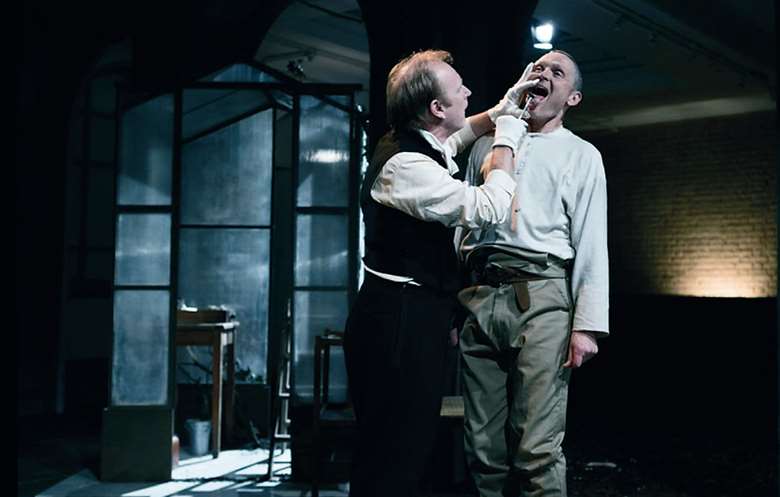Woyzeck by Georg Büchner
Laura Martin
Thursday, September 1, 2022
Each issue of D&T we bring you a teacher or academic's guide to a play for study with your students. This issue, Dr Laura Martin introduces Georg Büchner's Woyzeck

OMNIBUS THEATRE
Georg Büchner's short play is trailblazing in several ways. It foreshadows many literary and dramatic trends from 50-100 years after it was written, such as Naturalism, Social Realism and Existentialism. Its fragmentary or ‘open form’ structure lends it an ambiguity which can allow for varied and even contradictory interpretations. It has the first lower-class tragic hero in the western dramatic tradition. Sexuality and bodily functions are presented on the stage, although it is a serious, tragic drama, not a comedy. It is an eerie and haunting play that also includes biting social satire in a strange, explosive mix. Since its first performance nearly a century after its composition, it has become one of the most influential as well as most popular plays in the repertory in various countries.
Social Realism or Existential Terror?
Woyzeck is an early version of the working-class protagonist with whom we have great sympathy. He lives in a harsh world where he is abused, mocked and satirised by his social ‘betters’, the Captain and the Doctor. These two characters are entirely unlikeable; they are cardboard cut-outs with no depth. The scenes with these characters function as social satire. Compared to them Woyzeck is good-hearted and human.
But it's not so simple: from the opening scene he is also demonstrably insane, describing apocalyptic visions of heads rolling across fields and fire in the sky. Eventually, the voices he hears tell him to kill his common-law wife and mother of his child, Marie: he buys a knife and murders her at night outside the town.
Büchner's unfinished manuscript contained a series of short, enigmatic scenes, with little indication as to cause and effect between the plot elements. The order of the scenes was so unusual that until the 1980s it was altered to give what was felt to be a more logical progression. Yet Büchner's wishes seem clearly against such a logical form: he starts his version with scenes of Woyzeck's apparent madness, making its origin unknown.
This has led to two dominant, contrary interpretations, both of which can be supported by the text, but neither of which accounts for all its qualities. If the Captain and the Doctor are at fault for the eventual murder due to their low-grade torture of this vulnerable soul, then we have a case for Social Realism. This would align with Büchner's political views: he wrote seditious propaganda to try to get German peasants to rise up against the aristocracy. He was also clearly inspired to write this play by a real case of a man who pleaded innocent of murder due to insanity.
But this does not account for the terror and alienation present in the play, for example in Woyzeck's visions and in the desolate ‘anti-fairy tale’ that an old woman tells the children. In it, a child finds itself in a dead world within a dead cosmos, totally isolated from any living thing or any meaning. It also does not explain the murder of Marie. She is the only other named character, and like him, she has humanity and depth. Her wounding of him is unintentional: she sleeps with another, more virile man. Büchner depicts, with his eyes wide open, the common case of a woman being murdered by a man who has been alienated from society, but he does not condone it. Suddenly, it is no longer clear who is victim and who is perpetrator, since Woyzeck is both.
Themes
The question of natural bodily functions as opposed to rigidly rational and moral restraint figures largely in this short text, with several animals being favourably compared to one-sided humans. Marie and Woyzeck are the likeable, natural figures in comparison with the Captain and Doctor, who abuse their power in a way only a too-civilised human could do. Madness as a theme permeates the play: the two gentlemen are certainly ‘mad’ in one way, but Woyzeck, too, is mad. Is his sensitivity to the voices and visions possibly part and parcel of a greater natural spirituality, which his mistreatment at their hands has transformed into paranoia? Social class and gender are also important themes.
Performance
Woyzeck can be played as brightly-lit social satire or as a dark nightmare. The many binary oppositions can be highlighted: madness/sanity, natural/civilised, power/powerlessness, etc. The shortness of the scenes means simple staging, perhaps in a small, intimate space. The director will have to decide how sympathetically to present Woyzeck as murderer and Marie as adulteress. The starkness of the plot means the play can be adapted to very different settings: more modern, urban settings have been common (slum, prison, mental hospital, war zone and so on). It certainly lends itself to the study of such topical issues such as femicide, victimisation, madness and violence.
It is a bombshell of a text that will engender terrific discussions!
Links and Resources
-
Werner Herzog‘s Woyzeck, (Werner Herzog Film Production and ZDF, 1979)
-
William Kentridge's Woyzeck on the Highveld, can be watched here.
-
Georg Büchner: The Shattered Whole by John Reddick (Oxford: Clarendon Press, 1994)
-
Tom Waits’ ‘The Children's Story’ from Orphans: Brawlers, Bawlers and Bastards. The recitation of the ‘anti-fairy tale’ with illustrations by Matt Rosemier can be found here.

